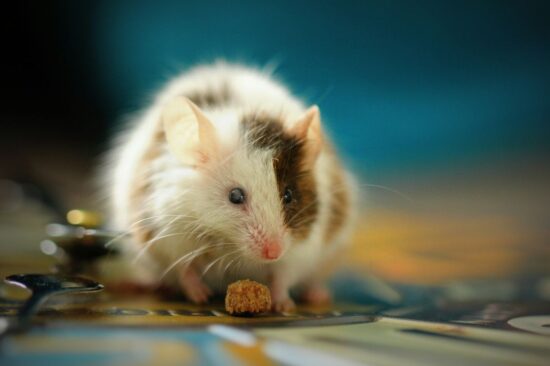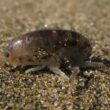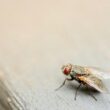Nobody wants to find mice in their home, but knowing what mouse poop looks like can help you catch a problem early. Mouse droppings are often the first sign that these tiny visitors have moved in, and spotting them quickly can save you from a bigger headache down the road.
Understanding what mouse droppings look like is important for your family’s health and safety. These small pellets can carry diseases and create serious problems if not handled properly. This guide will walk you through everything you need to know about identifying mouse droppings and what to do when you find them.
1. Size and Shape: The Rice Grain Test
The easiest way to identify what mouse poop looks like is to compare it to something you see every day: rice. Mouse droppings are about the same size as a single grain of rice, measuring between 1/8 to 1/4 inch long. They’re small enough that you might miss them at first glance.
Mouse droppings have a distinctive cylindrical shape with pointed ends on one or both sides. Think of them as tiny, dark torpedoes. When fresh, they have a smooth texture that sets them apart from other pest droppings you might find around your home.
If you’re trying to figure out what mouse droppings look like, the rice comparison is your best bet. They’re consistently small and uniform in size, unlike some other pests that leave behind irregular droppings.
2. Color: Fresh vs. Old Droppings
The color of mouse droppings can tell you a lot about how recent your mouse problem is. Fresh mouse droppings are typically dark black or dark brown with a moist, shiny appearance. They almost look wet when they’re brand new.
As mouse droppings age, they go through a noticeable color change. Within 48 to 72 hours, they start to fade and lose their shiny appearance. Old mouse droppings turn light brownish-grey and develop a dry, crumbly texture that can even look dusty.
Knowing what mouse poop looks like at different ages helps you understand whether you’re dealing with an active infestation or old evidence from mice that may have already left. Fresh, dark droppings mean the mice are probably still around and need immediate attention.
3. Quantity: Understanding Mouse Bathroom Habits
Here’s something that might surprise you: a single mouse can produce between 50 and 75 droppings every single day. That means if you find just a few droppings, there are likely many more hidden around your home.
Mice don’t use bathrooms like humans do. Instead, they leave droppings wherever they go, creating scattered trails along their regular travel routes. You won’t typically find mouse droppings in neat piles. They’re usually spread out in the areas where mice spend the most time.
The sheer number of droppings can help you understand the size of your problem. Large quantities of droppings indicate an active and possibly well-established mouse infestation that needs professional attention.
4. Common Locations: Where to Look for Mouse Poop
Understanding what mouse droppings look like is only half the battle. You also need to know where to look for them. Mice prefer dark, quiet areas that are close to food sources, so that’s where you’ll find most of their droppings.
Kitchen areas are hotspots for mouse activity. Check inside cabinets, pantries, and around food storage areas. Look along baseboards and in corners where mice like to travel. Don’t forget to check behind appliances like refrigerators, stoves, and water heaters.
Other common spots include attics, basements, crawl spaces, and utility closets. Mice also leave droppings in storage areas where they won’t be disturbed. If you have a garage or shed, these are worth checking too. Anywhere that’s dark, quiet, and offers shelter can become a mouse highway.
5. Mouse vs. Rat Droppings: Size Matters
One of the most common questions people have is how to tell the difference between mouse and rat droppings. The key difference is size. Rat droppings are much larger than mouse droppings, typically measuring 1/2 to 3/4 inch long.
While mouse droppings have pointed ends, rat droppings tend to have blunt, rounded ends. Rat droppings also look more like small sausages, while mouse droppings keep their rice-like appearance.
Rats produce fewer droppings per day than mice (around 20 to 50), but each dropping is significantly larger. When you’re trying to identify what mouse poop looks like versus rat poop, remember that mouse droppings are always much smaller and more numerous.
6. Mouse vs. Cockroach Droppings: Key Differences
Another common mix-up happens between mouse droppings and cockroach droppings. While both are dark and small, there are clear differences once you know what to look for.
Cockroach droppings look like ground coffee or black pepper. They’re typically smaller than mouse droppings and have a more granular appearance. Mouse droppings have smooth sides, while cockroach droppings often have ridges running along their length.
Here’s an easy way to tell them apart: mouse droppings have pointed ends, while cockroach droppings have blunt ends. Mouse droppings might also have tiny hairs stuck to them from the mouse’s fur, something you’ll never see with cockroach droppings.
7. Texture Test: Determining Freshness
The texture of mouse droppings can tell you important information about your infestation, but never test this with your bare hands. Always wear gloves if you need to handle droppings.
Fresh mouse droppings feel soft and moist. If pressed (again, only with gloves), they will squish slightly. This soft texture indicates recent mouse activity and suggests the mice are still actively using the area.
Old mouse droppings become hard and dry. They’ll crumble when crushed and may even turn to powder. Some old droppings can develop mold, which creates additional health risks. Understanding what mouse droppings look like at different stages of aging helps you assess your situation.
8. Health Risks: Why Identification Matters
Knowing what mouse poop looks like isn’t just about pest control. It’s also about protecting your family’s health. Mouse droppings can carry serious diseases including Hantavirus, salmonella, and leptospirosis.
These droppings also contain allergens that can trigger asthma attacks, especially in children. When mouse droppings dry out, they can become airborne and cause respiratory problems when inhaled.
Mouse droppings contaminate surfaces and food areas, spreading bacteria throughout your home. This is why quick identification and proper cleanup are so important. The sooner you recognize what mouse droppings look like and take action, the better you can protect your family.
9. Safe Cleanup Protocol: CDC Approved Methods
Once you’ve identified mouse droppings in your home, proper cleanup is critical for your safety. Never sweep or vacuum mouse droppings, as this can spread harmful particles into the air.
Start by opening windows and doors to ventilate the area for at least 30 minutes. Stay out of the area during this time. When you return, wear rubber gloves and a face mask, preferably an N95 respirator.
Spray the droppings and surrounding area with a disinfectant or a bleach solution (mix one part bleach with 10 parts water). Let it soak for at least five minutes. Use paper towels to carefully pick up the droppings and any contaminated materials. Double-bag everything in plastic bags before throwing it away.
Clean all hard surfaces in the area with disinfectant. Wash your hands thoroughly with soap and hot water after removing your gloves. If your clothes came into contact with droppings, wash them separately in hot water.
10. When to Call Professionals
Sometimes the mouse problem is too big to handle on your own. If you’re finding droppings in multiple rooms or large quantities in one area, it’s time to call pest control professionals.
You should also call experts if droppings keep appearing after you’ve cleaned them up. This indicates an active infestation that needs professional treatment. Pregnant women should avoid handling mouse droppings entirely and should call professionals for cleanup.
If you find droppings in your HVAC system, air ducts, or other areas that are hard to reach, professional cleanup is the safest option. They have the proper equipment and training to handle contaminated areas safely.
Taking Action Against Mouse Problems
Learning what mouse poop looks like is an important first step, but finding droppings means you need to address the bigger problem. Mice don’t just disappear on their own, and cleaning up droppings won’t solve an active infestation.
The key to success is combining proper identification with effective pest control. Seal up entry points around your home, store food in sealed containers, and consider setting traps in areas where you’ve found droppings.
Remember, mouse droppings are just the evidence of a larger problem. By knowing what mouse droppings look like and taking quick action when you find them, you can protect your home and family from the health risks and property damage that mice can cause. Don’t ignore these small signs of a potentially big problem.


